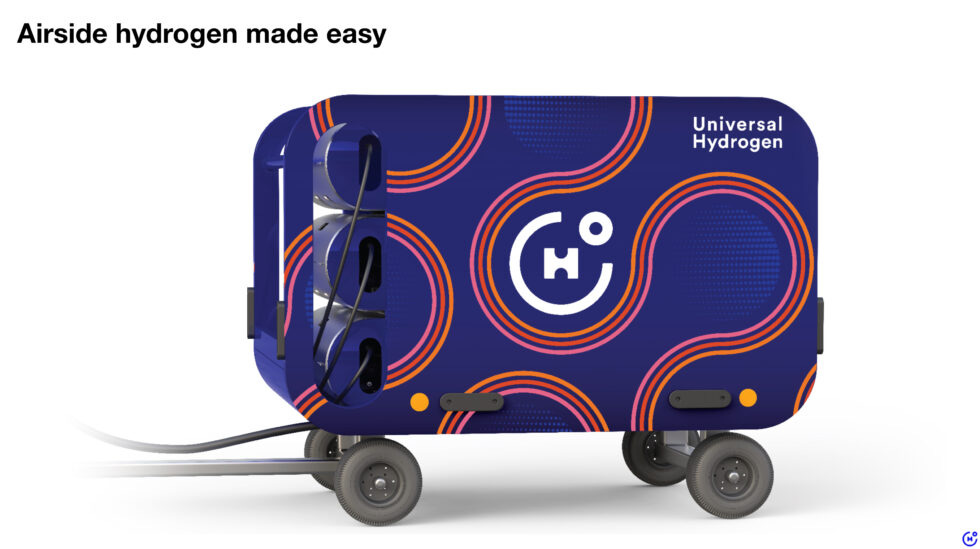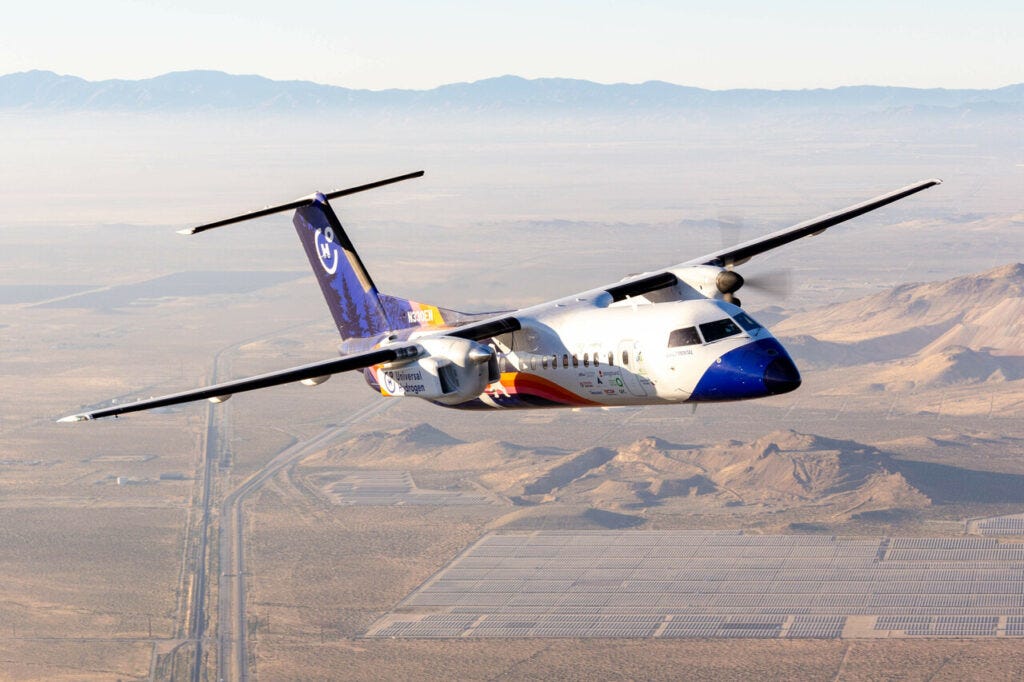From high hopes to hard landings: The Universal Hydrogen story and aviation's funding dilemma
Lessons from the demise of one of the brightest stars of sustainable aviation – and what it means for the future.
Executive summary
Universal Hydrogen, a promising startup developing Nespresso-style hydrogen retrofit solutions for aircraft, has shut down due to a lack of funding despite backing from major investors and successful test flights.
The collapse highlights the enormous capital requirements for decarbonising aviation.
Investment in sustainable aviation is skewed, with eVTOLs attracting significant funding while other innovations struggle. Many deals in the sector are non-binding LOIs and MOUs, lacking substantial financial commitments.
Our proposed solutions include redirecting investments; implementing a 'polluter pays' surcharge on those who fly the most; and pooling resources across the industry to fund transformative technologies.
Introduction
The startup that promised Nespresso-style hydrogen solutions for aircraft is no more. Despite backing from JetBlue Ventures, Toyota Ventures, and Airbus and successful test flights of its "Lightning McClean" Dash-8, Universal Hydrogen failed to secure vital funding to continue operations.
Simply put, the company ran out of money. The Seattle Times reports that the company couldn't secure a rights offering from existing investors or finalise a last-minute $20 million deal with a Saudi fund to keep the company afloat. Consequently, it had to shut down.
This outcome seemed unlikely, as it was clearly a leader among the hundreds of startups in this domain.
Universal Hydrogen took an innovative approach to retrofitting regional aircraft. CEO Paul Eremenko aptly compared it to a Nespresso-style solution in his interview on our podcast. Just as coffee pods are delivered to your Nespresso machine, Universal Hydrogen would supply hydrogen conversion kits and hydrogen 'pods' to aircraft like the ATR72.
It boasted a credible management team with experience. It demonstrated tangible progress – its converted Dash-8 aircraft was the largest hydrogen-electric aircraft to fly to date. And it had prominent backers.
Why couldn't it secure the necessary funds to continue innovating? One factor appears to be political uncertainty.
The Seattle Times suggests that the possible re-election of Donald Trump in November – who, over the weekend, wondered out loud how electric planes could remain airborne if it's not sunny – and the economic climate made some investors cautious.
It's all about capital
Ultimately, we must consider the sheer amount of money required to decarbonise aviation and where it's currently being allocated.
While writing our book, one theme surfaced repeatedly – money. There are promising technologies and hundreds of innovative startups, but bringing them to market will require enormous sums of capital.
The figure most commonly cited last year was $1 billion to produce a clean sheet aircraft. If anything, that may be conservative. Electric aircraft startup Elysian thinks $5 billion+ is more realistic.
Now, let's examine where funding is actually flowing.
When we consulted Lorenzo Chiavarini, Dealroom's authority on B2B venture capital research, he informed us that only five sustainable aviation companies had exceeded the $100 million funding threshold, including electric aircraft maker Heart Aerospace and hydrogen-electric powertrain company ZeroAvia. Universal Hydrogen was arguably the sixth, just shy of the $100 million mark.
However, one area is consistently attracting substantial investment: eVTOLs. Three times as many electric air taxi companies (which Dealroom.co, like many others, doesn't categorise under sustainable aviation) have received $100+ million in investments, with investors excited by the vision of George Jetson-style flying cars cruising above cities.
Airlines favour them too, viewing these air taxis as a means of transporting elite flyers from city centres to airports, bypassing the traffic jams down below, before embarking on carbon-intensive long-haul flights.
Meanwhile, companies like Universal Hydrogen and others in this space do garner interest. Every week, we see press releases about Startup A signing a deal with Airline B.
“Letters of Imagination”
The issue is that these are predominantly LOIs and MOUs. As Adam Forsyth aptly stated at the recent Revolution.aero conference, you might as well refer to LOIs and MOUs as "Letters of Imagination” and "Murmurs of Unicorns" – great for PR but lacking substance or financial commitment.
Furthermore, you could question whether there's even an appetite in some industry sectors for new propulsion systems like electric or hydrogen.
Record orders are being placed for kerosene-powered wide-body aircraft. These planes will operate for 20-30 years, and much of the industry is reluctant to abandon decades-old technology. Hence, there's an emphasis on SAF, which raises concerns about postponing genuine transformational change.
Clearly, we'll need SAF in very large quantities for the medium term, but at the same time, we can't indefinitely delay embracing true zero-emission solutions.
The solutions
1. Redirect the cash flow
We're funnelling millions into air taxis while true game-changers struggle. Yes, some eVTOL companies like Eve Air Mobility have put forward interesting use cases like island-hopping in Norway or rural Kenya connectivity.
However, the overall investment strategy is lopsided. We need to turbocharge funding for innovations that will truly transform aviation.
3. Make the polluter pay
Aviation’s $4-5 trillion price tag for decarbonisation represents a huge sum of money.
The ICCT has an answer, which we gave qualified support to in our book: a flight frequency surcharge.
The first flight would be exempt, with the 20th incurring a $177 levy – a manageable amount for most people flying 20+ times annually. The ICCT suggests this approach would generate most of the funds needed to decarbonise the industry.
Consequently, Lufthansa's recent announcement of a climate ticket surcharge is interesting. But we need more transparency on fund allocation; moreover, the surcharge amount doesn't vary based on flight frequency (i.e. everyone is taxed equally).
3. Pool resources for greater impact
Last year, we questioned whether individual airlines establishing $100-200 million funds would significantly improve the situation and whether pooling these funds into one large pot might be more effective in achieving goals like launching a new electric aircraft.
United's pooled SAF fund that collaborates with competitors to source alternative fuels, is a positive step in this direction.
4. Work with the corporate sector
We recently wrote about the e-fuels company Infinium, which had secured investment from Breakthrough Energy based on a ‘bankable’ offtake agreement with American Airlines. This, in turn, was backed by financial giant Citi, which will use the SAF towards its Scope 3 emissions.
The pragmatic outlook
Realistically, we have no alternative. Even with another potential Trump term, countries worldwide will introduce SAF mandates – reportedly even China. Meanwhile, other nations will follow France's example in restricting domestic fossil fuel flights or Norway and Sweden's plans to do away with them entirely by 2040.
Nevertheless, at SimpliFlying, we remain optimistic that these goals are achievable. We agree with veteran climate tech investor Sean O'Sullivan, who predicts that 500+ unicorns will emerge since entire industries, including aviation, need to be transformed.
Consequently, the aviation industry stands at a crossroads. Continuing business as usual risks more Universal Hydrogens failing. But embracing change could unlock what O'Sullivan terms the investment opportunity of the century.
The future of aviation hangs in the balance. Who will seize the opportunity?








